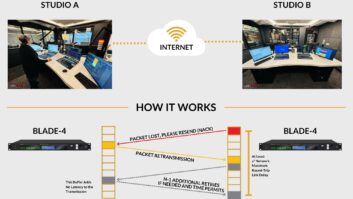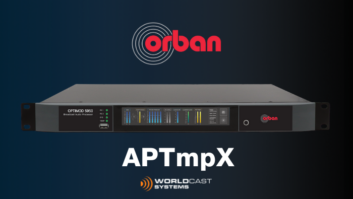The FM exciter’s reflected power is a good place to start your “inside” transmitter site inspection checklist …
(click thumbnail)Fig. 1: Bird Technologies Group Broadcast Applications Engineer Bill Tobin and Customer Service Representative Nancy Black demonstrate a free slide rule that calculates FM transmission parameters. We said earlier that the FM exciter’s reflected power is a good place to start your “inside” transmitter site inspection checklist.
Check the reflected power on the transmitter itself. In this case, high reflected power indicates antenna matching problems. VSWR, return loss, match efficiency and reflection coefficient are related to forward and reflected power levels.
To assist in their calculation and inter-relation, Bird Technologies Group offers a handy cardboard “slide rule” calculator that shows each of these parameters as they relate to the transmitter output power and reflected power levels. This slide rule will be helpful particularly to contract engineers, who must visit and evaluate multiple sites.
This slide rule is free, but quantities are limited. While supplies last, send a request to Nancy Black at Bird Technologies. Let her know you read about the slide rule in Radio World’s Workbench.
If you’re doing any HD installs, have Nancy include a data sheet on Bird’s new BPME, the company’s HD power meter, a must-have for the HD site. You can obtain more information on Bird’s product line by heading to www.bird-technologies.com
. . .
(click thumbnail)Fig. 2: Keep reflected power as close to zero as possible. This reading is less than desirable.
Whether you use the slide rule calculator or just read the Reflected Power Meter on the transmitter, like the exciter, this reading should also be low. A higher reading, as shown in Fig. 2, signifies a problem.
Depending on the transmitter output power, the reflected power value could be anywhere from 20 watts to as much as 100 watts on a 20 kW transmitter. If the output transmitter meter displays forward power, check that it is at the FCC-licensed value for transmitter power output, or TPO.
As you look over the transmitter meters, do a calculation of the indirect power for FM (Ep x Ip x effy = Indirect Power).
The efficiency factor, or “effy,” can be found from the transmitter test data sheets or in the transmitter manual and should be posted if you determine power using this method.
If you cannot locate the transmitter test data, contact the manufacturer’s field service department. The major transmitter manufacturers keep copies of this test data and will share it with you.
If there is no test data sheet and the transmitter is out of production, like the RCA BTF series, check the instruction manual for an efficiency chart.
Again, if you measure power indirectly, photocopy this efficiency sheet and post it at the transmitter site. An FCC inspector or Alternative Inspection engineer will most likely want to see it to determine that you are calculating output power properly.
. . .
While we’re on the subject of FM power: New licenses do not include the antenna gain or transmission line losses, and simply show the FM power in effective radiated power. Be prudent; keep a copy of the engineering calculations as to how you determined the ERP.
On older stations, it can’t hurt to run the calculations again. You might be surprised to learn that as stations change hands, antennas too are changed, sometimes to a different number of bays, without most people involved realizing it. An antenna system may not consist of the same elements as when it was licensed 15 or 20 years ago. Even a change in the size of the RF feedline will have an effect.
(click thumbnail)Fig. 3: Keep a written record of high-power tube serial numbers.
Although it’s not required by the FCC, take a set of transmitter meter indications. This is just good engineering practice. A set of readings taken under normal conditions can aid in troubleshooting a problem later. If measurements are taken monthly, you can spot trends.
(click thumbnail)Fig. 4: Monitor line air pressure; it should never read zero.
If the transmitter uses tubes, take advantage of the filament hours meter. Record this indication, especially when changing tubes. The tube warranty is calculated based on the hours the tube has been in use. This is true for new tubes and rebuilds. In your log, copy the serial number of your power tubes. The serial number usually is found on the side of the tube, as seen in Fig. 3.
Another critical meter should be read if you maintain an FM site: the line pressure meter. This may be located on the end of the transmission line, connected to a meter/valve manifold or run directly off the nitrogen tank valve assembly. Fig. 4 shows a typical valve assembly.
Regardless of its location, an indication of positive line pressure is crucial. When the line is purged with positive air pressure, moisture can’t enter the transmission line.
This is probably one of the most overlooked and misunderstood meters, yet one whose indication can warn of impending danger. If the line pressure goes to zero, you could have moisture or condensation form inside the line. As the moisture builds, the impedance of the line changes, and reflected power increases.
At some point, the line will flash over and burn. The resulting damage can destroy the antenna, the line and possibly the transmitter – not the sort of accident you want on your watch.















